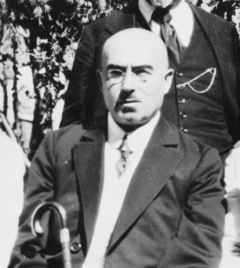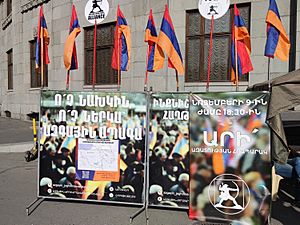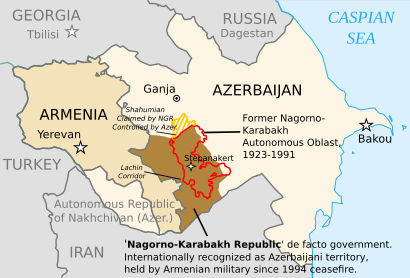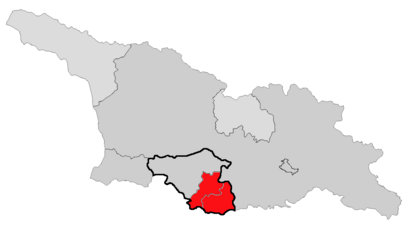United Armenia facts for kids
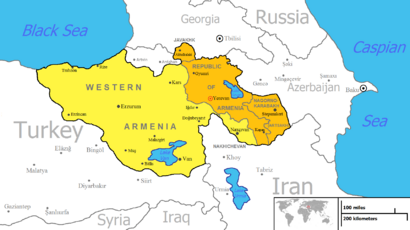
Orange areas have many Armenians.
Yellow areas used to have many Armenians but now have few or none.
Note: Artsakh (Nagorno-Karabakh) is shown with its borders before the 2020 Nagorno-Karabakh war.
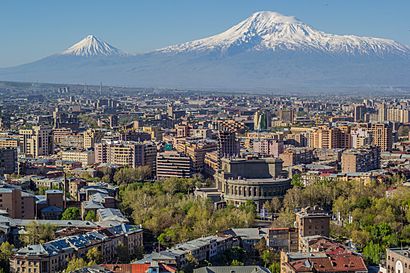
United Armenia (Armenian: Միացեալ Հայաստան, romanized: Miats'eal Hayastan) is an idea among some Armenians. It means bringing together areas that are part of the traditional Armenian homeland. These lands are in the Armenian Highland. They have been, or still are, mostly home to Armenian people. This idea of uniting historical Armenian lands became popular in the 1900s. Many groups and people support it. These include the Armenian Revolutionary Federation (ARF) and Heritage political parties.
The ARF's idea of "United Armenia" includes several areas. These are Western Armenia (now eastern Turkey), Nagorno-Karabakh (Artsakh), and Nakhchivan. Nakhchivan is a landlocked area in Azerbaijan. The idea also includes the Javakheti (Javakhk) region of Georgia. Nagorno-Karabakh and Javakhk have many Armenians living there. Western Armenia and Nakhchivan had many Armenians long ago, but not anymore. Most Armenians in Western Armenia were killed during the Armenian genocide in 1915. This event largely ended the Armenian presence there. In 1919, the government of the First Republic of Armenia officially said it wanted to unite Armenian lands. The ARF bases its claims on the 1920 Treaty of Sèvres. This treaty was later cancelled by other events.
The most recent movement to unite lands was the Karabakh movement. It started in 1988. It aimed to join Nagorno-Karabakh with Soviet Armenia. After a war with Azerbaijan, Armenian forces took control of most of Nagorno-Karabakh. They also controlled nearby areas. This created a de facto (in reality, but not officially) union of Armenia and Karabakh. Some Armenian nationalists see this as the first step toward a "United Armenia."
Contents
History of Armenian Land Claims
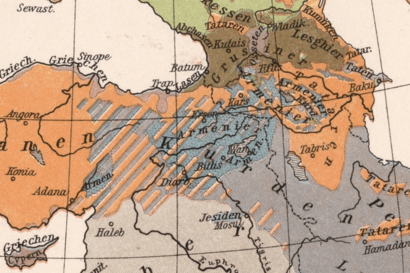
Early Ideas of United Armenia
The idea of "United Armenia" as we know it today started in the late 1800s. This was during a time when Armenians were becoming more aware of their national identity. Back then, Armenian lands were split between the Russian Empire (Eastern Armenia) and the Ottoman Empire (Western Armenia).
One of the first times "United Armenia" was mentioned was in 1899. A report to Tsar Nicholas II of Russia talked about a movement. This movement wanted to bring back an independent Armenia. Its goal was "one great and united Armenia."
Having an independent and united Armenia was a main goal for Armenians in the late 1800s and early 1900s. There were some small fights between Armenian groups and the Ottoman government. Between 1894 and 1896, up to 300,000 Armenian civilians were killed. This was ordered by Sultan Abdul Hamid II. After 1908, some Armenians hoped things would get better. But in 1909, more violence happened.
World War I and the Armenian Genocide
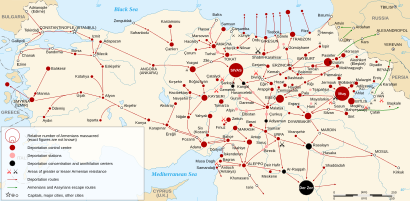
In 1915 and the years after, the Ottoman government killed many Armenians in eastern Ottoman Empire. About 1.5 million Armenians died. Those who survived found safety in other countries. These events are known as the Armenian genocide. The Turkish government today says these killings were part of a "civil war," which is not true. The genocide ended the Armenian presence in Western Armenia that had lasted for over two thousand years.
By 1916, the Russian Empire took over most of Western Armenia during World War I. But after the Revolution of 1917, the Russian army left. The Ottoman Empire quickly took back these lands. Armenian units fought back. They defeated the Turks at the Battle of Sardarabad. This battle saved the Armenian nation from being completely destroyed.
In 1919, American experts Lothrop Stoddard and Glenn Frank wrote about a "United Armenia." They said it would be a union of lands from Turkish, Russian, and Persian Armenia. They noted that Armenians would not be the majority in most of these areas.
First Republic of Armenia: 1918–1920
Armenian leaders declared their independence on May 28, 1918. After the Ottoman Empire lost World War I, its troops left the Caucasus. By 1919, the Republic of Armenia controlled more land, including Mount Ararat.
On May 28, 1919, Armenia's government declared the union of Eastern and Western Armenia. Western Armenia was still controlled by the Turks. Alexander Khatisian, the Prime Minister, read the declaration. He said that all separate parts of Armenia were now one independent country. He called it the "United Republic of Armenia."
Treaty of Sèvres
On August 10, 1920, the Treaty of Sèvres was signed. It was between the Ottoman Empire and the Allied Powers. The United States President Woodrow Wilson was asked to help draw the border between Armenia and Turkey. He agreed.
The treaty gave Armenia about 40,000 square miles (103,600 square kilometers) of land from the Ottoman Empire. This land would have given Armenia access to the Mediterranean Sea. The plan was that if Armenian refugees returned, they would make up about half of the population. President Wilson signed the border decision on November 22, 1920.
However, the Treaty of Sèvres was never fully put into action. It was replaced by the Treaty of Lausanne in 1923. This new treaty led to the creation of modern Turkey.
Fall of the First Republic
In late 1920, a war started between Armenia and Turkish nationalists. The Turks captured the city of Kars. At the same time, Soviet forces invaded Armenia. On December 2, 1920, Armenia became a Soviet state. Armenia was forced to sign the Treaty of Alexandropol. This treaty meant the Treaty of Sèvres and Wilson's border plan were ignored.
In March 1921, Soviet Russia and Turkey signed the Treaty of Moscow. This treaty gave Kars and Ardahan to Turkey. It also put Nakhichevan under Azerbaijan's control. The Treaty of Kars later confirmed these decisions.
After World War II: 1945–1953
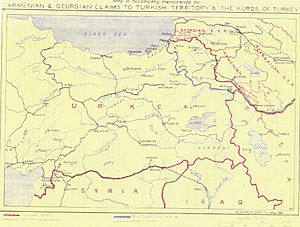
After World War II, the Soviet Union wanted some land back from Turkey. These were the areas of Kars and Ardahan. Soviet leader Joseph Stalin wanted to return to the borders that existed before World War I.
To bring more Armenians to these claimed areas, the Soviet government helped Armenians living abroad to return. Between 1946 and 1948, about 90,000 to 100,000 Armenians moved to Soviet Armenia. These were mostly survivors of the Armenian Genocide.
The head of the Armenian Church, Gevorg VI, hoped that Armenians would get justice. He wanted "Turkish Armenia" to be freed and joined with Soviet Armenia. Armenian leaders also supported these claims. But as relations between the Soviet Union and Western countries got worse, these claims were dropped by 1947. The Soviet Union officially gave up its claims in 1953, after Stalin died.
Late Cold War: 1965–1987
A new wave of Armenian nationalism began in the mid-1960s. This was when the Soviet Union allowed more freedom. On April 24, 1965, a large protest happened in Yerevan. It was the 50th anniversary of the Armenian Genocide. Thousands of Armenians gathered to remember the victims. They wanted the Soviet government to help them get back their lost lands. The government then built a memorial for the genocide.
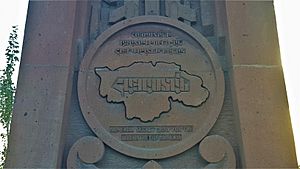
In the 1960s and 1970s, some secret groups fought against the Soviet Union and Turkey. In 1966, the National United Party was formed in Soviet Armenia. It wanted a United Armenia through self-determination.
By the 1970s, getting Turkey to recognize the Armenian Genocide became very important. Armenian groups believed that if Turkey recognized the genocide, it would help their claims to Western Armenia. From the mid-1970s to the late 1980s, some Armenian militant groups acted in the Middle East and Europe. The Armenian Secret Army for the Liberation of Armenia (ASALA) attacked Turkish diplomatic offices. The idea of United Armenia was one of ASALA's main goals.
Nagorno-Karabakh Wars: 1988–2020
In February 1988, a popular movement started in Soviet Armenia and Nagorno-Karabakh Autonomous Oblast (NKAO). NKAO was a small Armenian area controlled by Soviet Azerbaijan. The movement wanted to unite these two areas. This brought back the idea of a united Armenia.
On February 20, 1988, Nagorno-Karabakh's local government asked to join Soviet Armenia. Moscow said no. Hundreds of thousands of people protested in Yerevan to support the idea. A few days later, violence against Armenians broke out in Sumgait, Azerbaijan. This made thousands of Armenians leave Azerbaijan.
On June 15, 1988, Soviet Armenia's government voted to accept Nagorno-Karabakh. But Azerbaijan refused to give up the area. In December 1989, Soviet Armenia and NKAO declared their union. In January 1990, more violence against Armenians happened in Baku. Many Armenians left Azerbaijan, and many Azerbaijanis left Armenia.
The conflict grew into a full war. Armenian forces took control of Nagorno-Karabakh and several surrounding districts. A ceasefire was signed in May 1994. Since then, the Armenian Nagorno-Karabakh Republic controlled these lands.
However, in the 2020 Nagorno-Karabakh war, Armenian forces lost control of many areas around Nagorno-Karabakh. They also lost parts of Nagorno-Karabakh itself. A new ceasefire agreement was made. Russian peacekeepers are now in the Lachin corridor. This corridor connects Armenia to Nagorno-Karabakh.
Groups Supporting United Armenia
Armenian Revolutionary Federation
The Armenian Revolutionary Federation (ARF) is a political party. It was founded in 1890. It has always been the main group supporting United Armenia. The ARF has groups in Armenian communities around the world. It is one of the most important Armenian organizations.
The ARF says that historical justice will happen when Armenians return to a united Armenia. This Armenia would include its current borders, plus Western Armenia, Nagorno-Karabakh, Nakhichevan, and Javakhk. The party's main goal is "The creation of a Free, Independent and United Armenia."
In 2004, ARF leader Hrant Markarian said: "We will keep pushing Turkey until we win completely. This means until the genocide is recognized and until a United Armenia is created."
Heritage Party
The Heritage party is another political group. Its official plan does not directly mention land claims. But its leader and some members have supported these ideas. Heritage wants Armenia to officially recognize the Nagorno-Karabakh Republic. They have tried to pass laws for this in the Armenian Parliament.
Raffi Hovannisian, the leader of Heritage, has spoken about Western Armenia, Javakhk, and Nakhichevan. He uses general words, but suggests these areas are important for Armenia's future. In 2015, Hovannisian wrote that Turkey occupies Western Armenia. He called for "the creation of an Armenian national hearth in historic Western Armenia."
Other Supporters
The Armenian Democratic Liberal Party (ADL) also supports Armenian land claims. In 1990, an ADL leader said that the Republic of Armenia is the start of a future "Greater Armenia." He said the new government should work to get back Armenia's historical rights. This includes getting the Armenian Genocide recognized and getting back historical lands.
Lands Claimed by Some Armenians
The Armenian Revolutionary Federation (ARF) talks about "United Armenia." This idea includes these areas:
| Area | Part of | Area (km²) | Population | Armenians | % Armenian | Source |
|---|---|---|---|---|---|---|
| Nagorno-Karabakh | 11,458 | 145,053 | 144,683 | 99.7 | 2015 census | |
| Javakhk | 2,588 | 69,561 | 65,132 | 93.6 | 2014 census | |
| Nakhichevan | 5,363 | 398,323 | 6 | ~0 | 2009 census | |
| Western Armenia | 132,967 | 6,461,400 | 60,000 | 0.09 | 2009 estimate |
Nagorno-Karabakh (Artsakh)
After the First Nagorno-Karabakh War, the Nagorno-Karabakh Republic took control of about 11,500 square kilometers of land. This included areas outside its original borders. This created a "buffer zone." Many Azerbaijanis had to leave this area. At the same time, most Armenians in Azerbaijan and Azerbaijanis in Armenia also had to move. This happened because of the conflict.
The Nagorno-Karabakh Republic is also called Artsakh by Armenians. Most countries do not officially recognize it as an independent state. Today, Armenia and Nagorno-Karabakh work like one country. However, the land of Nagorno-Karabakh is officially part of Azerbaijan to most of the world. Nagorno-Karabakh has a very high Armenian population, about 99.7%. The Azerbaijani people who lived there left during the war.
Since the 1994 ceasefire, Armenia and Azerbaijan have been talking to try and find a solution. But there are still often small fights along their border.
Javakhk (Javakheti)
Javakhk is a region in Georgia. It includes the areas of Akhalkalaki and Ninotsminda. Most people living there are Armenian (about 95%). This area is somewhat separate from the rest of Georgia. It is also not as developed economically.
Some people say that it is easier to use Armenian than Georgian in this region. Armenians in Javakhk generally live peacefully with Georgians. But they sometimes worry about the future. Javakhk was a disputed area between Armenia and Georgia from 1918 to 1920.
A local group called the United Javakhk Democratic Alliance wants Armenians in the region to have more self-rule. They want a vote on this. This group is thought to be close to the Armenian Revolutionary Federation. The ARF says it wants a strong and self-governing Javakhk within Georgia.
The Armenian government has not made land claims to Georgia. It also has not asked for self-rule in Javakhk. Relations between Armenia and Georgia are usually friendly. But sometimes, there are disagreements. For example, about Armenian churches in Georgia.
Western Armenia (eastern Turkey)
Western Armenia is an area in eastern Turkey. Before the Armenian genocide in 1915, many Armenians lived there. After the genocide, almost no Armenians officially live there today. However, some people of Armenian origin still live there. These include Hemshin peoples and "Hidden Armenians." Many "Hidden Armenians" have adopted other cultures.
Most Armenian nationalist groups claim the area east of the border drawn by US President Woodrow Wilson in 1920. This border was part of the Treaty of Sèvres. The Armenian Revolutionary Federation believes this treaty is the only legal document for the border between Armenia and Turkey.
Armenia's former Deputy Foreign Minister Ara Papian says that "Wilsonian Armenia" is still legally part of Armenia. He says the Treaty of Kars, which set the current border, is not legal. This is because it was signed by groups not fully recognized at the time. Papian has suggested Armenia could go to the International Court of Justice to challenge the border.
Some Armenians celebrate November 22 as the anniversary of Wilson's border decision. In 2010 and 2011, maps of the Treaty of Sèvres were put up in Yerevan.
On August 10, 2020, three Armenian political parties released a statement. They said the Treaty of Sèvres is the only international document defining the border between Armenia and Turkey. They called it a "promissory note based on international law."
Armenia's Official View
Since Armenia became independent in 1991, its government has not officially claimed land from Turkey. However, Armenia has not formally recognized the current border with Turkey. In 2001, Armenian president Robert Kocharyan said that recognizing the genocide would not lead to land claims.
In 2010, Armenian President Serzh Sargsyan spoke about Wilson's border decision. He called it a very important event for Armenians. He said it was meant to bring back historical fairness.
On July 23, 2011, President Sargsyan was asked if Turkey would "return Western Armenia." He replied that it depends on the younger generation. He said his generation defended Karabakh. He believes each generation has its duties. He said Armenia should be a modern, safe, and rich country. He said the country's size is not the most important thing.
Turkish officials saw Sargsyan's words as encouraging young Armenians to fight Turkey. Turkish Prime Minister Recep Tayyip Erdoğan called Sargsyan's statements a "provocation." He demanded an apology. Armenia's Deputy Foreign Minister said Sargsyan's words were misunderstood.
On July 5, 2013, Armenia's Prosecutor General Aghvan Hovsepyan made a strong statement. He said Armenia should get back its lost lands. He also said genocide victims should get money. He said churches in Turkey should be returned to the Armenian Church. This was seen as the first official land claim by Armenia to Turkey. Turkey's government strongly criticized Hovsepyan's statements. They said no one can claim land from Turkey.
On August 10, 2020, Prime Minister Nikol Pashinyan and President Armen Sarkissian spoke about the Treaty of Sèvres. Pashinyan said it was a historical fact that shows Armenia's journey to independence. Sarkissian said it is still important for Armenians to get a fair solution to their issues.
Nakhichevan
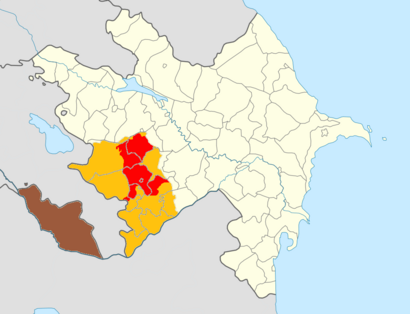
Armenian stories say that Nakhichevan was founded by Noah. Armenians have lived there for a very long time. In the 1600s, the Persian ruler Shah Abbas I forced about 300,000 Armenians to leave their homes. This included Armenians from Nakhichevan. He did this to prevent the land from falling to the Ottoman Empire.
After a war in 1828, Nakhichevan became part of Russia. At that time, about 34% of the people in Nakhichevan were Armenian. Before World War I, it was about 40%. Nakhichevan was fought over by Armenia and Azerbaijan from 1918 to 1920. Many Armenians left during this time.
After the Soviet Union took control, the Treaty of Moscow in 1921 made Nakhichevan an "autonomous territory" under Azerbaijan. The Treaty of Kars confirmed this. By the mid-1920s, the number of Armenians in Nakhichevan had greatly decreased. By 1979, only 1.4% of the population was Armenian. The last few thousand Armenians left Nakhichevan in 1988.
In the 1980s, some Armenians wanted Nakhichevan to join Armenia. They pointed to how the Armenian population in Nakhichevan had almost disappeared. During the First Nagorno-Karabakh War, there were fights on the Nakhichevan-Armenia border. But the war did not spread deeply into Nakhichevan. Turkey, an ally of Azerbaijan, said it would step in if Armenia invaded Nakhichevan.
In the 2000s, there was concern about the destruction of an Armenian cemetery in Julfa, Nakhichevan. Many Armenian churches, monasteries, and cemeteries were destroyed by Azerbaijan in the 1990s.
The Armenian government has never claimed Nakhichevan. However, some nationalist groups have called for taking Nakhichevan if Azerbaijan attacks Nagorno-Karabakh.
Public Opinion
There are no official surveys about the "United Armenia" idea. But it is popular among Armenians, especially those living outside Armenia. Many Armenians feel a deep sense of unfairness because Turkey denies the genocide and has not paid for the losses.
A 2014 survey in Armenia asked what demands Armenia should make to Turkey. About 80% said Armenia should make land claims. This included 30% who said only land claims, and 50% who said land, moral, financial, and property claims. Only 5.5% said no demands should be made.
On Artsakh
A 2017 survey in Armenia found that 86.4% of people did not want to give up any land in the Karabakh conflict. Only 8.2% would accept giving up land for peace.
A 2013 survey asked if Nagorno-Karabakh should be a formal part of Armenia. 77% of people strongly agreed. 13% would accept it under some conditions. Only 7% were against it.
In Culture
The idea of a united Armenian state has been a main topic in Armenian songs. Singers like Nersik Ispiryan and Harout Pamboukjian are famous for these songs. One popular song is "We must go" (Պիտի գնանք, Piti gnank). It talks about going to the homeland, putting a flag on Mount Ararat, and overcoming obstacles.
From 2005 to 2008, Armenian animator Robert Sahakyants made four short cartoons called Road home. They tell the story of children from Karin (Erzurum) in the year 2050. They travel through lands "freed from the enemy." These lands include Tigranakert, Baghesh (Bitlis), Mush, and Akdamar Island. The country they live in is called Hayk' . This is an old name for Armenia. The cartoons were shown on Armenian television. Sahakyants believed that Western Armenia would definitely be returned.
Reactions to the Idea
In Armenia
Armenia's first president, Levon Ter-Petrosyan (1991-98), spoke about the Nagorno-Karabakh conflict. He said that if Armenia officially demanded "the return of Armenian lands" from Turkey, it would only hurt Armenia. He said it would make Turkey think Armenia has plans to expand.
Gerard Libaridian, a former advisor to President Ter-Petrosyan, criticized recent statements by Armenian leaders. He said that adopting the Treaty of Sèvres as a foreign policy goal is like declaring a "diplomatic war against Turkey."
In Azerbaijan
Azerbaijani President Heydar Aliyev said in 1998 that the idea of "greater Armenia" was spread to remove Azerbaijanis from their lands.
In 2012, Ilham Aliyev, the current President of Azerbaijan, said that Armenians have committed crimes to achieve their "Great Armenia" goal. He said these crimes include terrorism and ethnic cleansing.
In Turkey
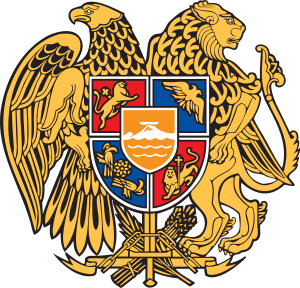
In December 1991, Turkey was one of the first countries to recognize Armenia's independence. But relations between Armenia and Turkey got worse during the First Nagorno-Karabakh War. Turkey supported Azerbaijan. Turkey and Azerbaijan share Turkic heritage and are often seen as allies. They often use the phrase "one nation, two states."
In Turkey, many people believe that Armenia's land claims are why Armenian groups want the Armenian Genocide recognized worldwide. The Turkish Ministry of Culture and Tourism says the idea of "Great Armenia" comes from Armenian President Levon Ter-Petrosyan. Some Turkish experts say that Armenia's failure to recognize the Kars Agreement and calling eastern Turkey "Western Armenia" bothers Turkey. They also point to Mount Ararat on Armenia's national symbol. They see this as a sign that the "greater Armenia" idea is still alive.
Some Turkish foreign policy experts say that Armenia has land claims on Turkey. They point to parts of the Armenian Constitution and Declaration of Independence. Article 11 of the Declaration of Independence says: "The Republic of Armenia supports getting international recognition of the 1915 Genocide in Ottoman Turkey and Western Armenia."
Turkish historian Umut Uzer said that Armenian land claims to eastern Turkey are "racist" and "expansionist." He said this is because the area has never had an Armenian majority. He also said these claims are supported by genocide claims, which deny Turkey's current borders.
See also
 In Spanish: Gran Armenia para niños
In Spanish: Gran Armenia para niños
|
|
Images for kids


